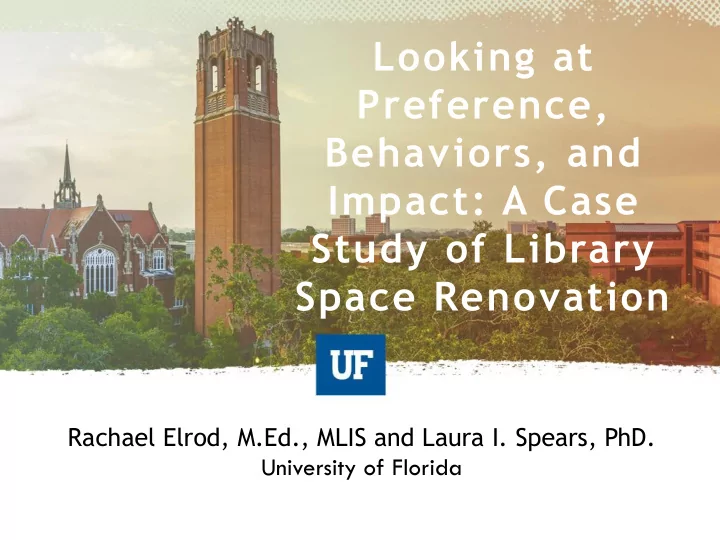

Looking at Preference, Behaviors, and Impact: A Case Study of Library Space Renovation Rachael Elrod, M.Ed., MLIS and Laura I. Spears, PhD. University of Florida
• Top 10 Best Public Universities in United States • Over 54,000 students • 7 Libraries
University of Florida
Introduction
Introduction “SO convenient to where I live. It makes me feel safe knowing I can study late and walk home without a trek. It’s also incredibly quiet, unlike most libraries on campus.”
Introduction
Purpose of the Study Design G a t h e r p a t r o n i n p u t u s i n g m u l t i p l e m e t h o d s t h a t m i x q u a l i t a t i ve a n d q u a n t i t a t i ve d a t a c o l l e c t i o n p r o c e s s e s . 1. What do our patrons think about the space? 2. What can we observe about space usage? 3. What organizational statistics can we examine to compare before and after?
Design Elements 1. What do our patrons think about the space? Qualtrics Online Survey Software Pre-renovation survey Target Audience of likely users to include: • Education faculty, staff, and students • Sorority members Distribution: • Email • Social media • Posters • Table tents • Word-of-mouth
Survey Instrument Survey Question Topics Demographics Awareness Frequency of Visits Feature Use Feature Satisfaction Feature Importance Scholarly Impact Recommendations for Future
Survey Discipline (n=729) 0 50 100 150 200 250 300 350 400 Education 54.4% Liberal Arts & Sciences 9.2% Business 8.2% Engineering 7.6% Agricultural & Life Sciences 4.7% Nursing 3.5% Public Health & Health Professions 2.8% Health and Human Performance 2.7% Journalism and Communications 2.5% Medicine 2.1% Other 2.4%
Survey Awareness of the Education Library (n=712) No 1% Yes 99%
Survey University Status 31, 4% 23, 3% 16, 2% 339, 47% 316, 44% Undergraduate Graduates Staff Faculty Alumni/Other
Survey Frequency of Computer Use Frequency of Visits Never Once or Once or Once or Daily twice a twice a twice a semester month week 0 0 0 0 0 Never Once or twice a semester 73.0% 24.6% 0.8% 0.8% 0.8% 39.8% 35.9% 22.7% 0.8% 0.8% Once of twice a month 37.8% 22.4% 22.0% 17.0% 0.8% Once or twice a week Daily 35.7% 21.4% 20.0% 15.7% 7.1% 45.4% 25.7% 17.4% 9.8% 1.6% Total
Survey Frequency of Librarian Assistance Once or Once or Once or twice a twice a twice a Frequency of Visits Never semester month week Daily Total Never 0 0 0 0 0 0 Once or twice a semester 69 52 2 0 0 123 Once of twice a month 63 50 15 0 0 128 Once or twice a week 142 77 26 13 0 258 Daily 36 20 6 7 1 70 Total 310 199 49 20 1 579
Design Elements 2. What can we observe about space usage? Unobtrusive Observations
Unobtrusive Observations First Floor Second Floor
Unobtrusive Observations Day People Laptop Tablet Drink Book Food Headphones Using Tech Sunday 1 36 32 0 23 2 2 5 0 Sunday 2 45 40 0 28 5 0 10 0 Monday 1 89 69 1 58 9 7 29 0 Monday 2 98 81 0 60 10 6 32 0 Tuesday 1 103 83 0 67 3 3 27 0 Tuesday 2 118 98 1 76 4 0 47 0 Wednesday 1 75 59 1 51 2 11 14 1 Wednesday 2 104 87 0 71 0 12 16 1 Thursday 1 73 61 0 41 2 8 16 0 Thursday 2 100 85 0 50 1 3 26 0 Friday 1 58 45 2 40 1 5 25 0 Friday 2 62 51 0 41 0 8 23 0 Saturday 1 32 30 1 21 0 4 15 3 Saturday 2 41 37 1 39 0 37 15 0 Total 1034 858 7 656 39 109 300 2 Median 74 60 0 45 2 5.5 19.5 0
Design Elements 3. What statistics can we gather to compare? Existing statistics Traffic sensors Circulation Computer Usage
Organizational Data Traffic Sensors
Organizational Data Traffic Sensors
Organizational Data Self-reported Traffic 37, 5% 78, 11% 290, 42% 143, 20% 152, 22% Once or twice a week Once or twice a semester Once or twice a month Daily Never
Organizational Data Circulation Course General Children’s K-12 Journals Reserves Collection & Young Textbooks Adult Spring 2017 858 1070 835 12 26 Fall 2017 634 953 1603 46 63 Spring 2018 222 N/A N/A N/A 0 Fall 2018 Spring 2019
Organizational Data Public Access Computer Usage Workstations Unique Logins Unique Users Application (Sessions) Launches Fall 2016 18 1,575 843 3,020 Spring 2017 18 1,685 699 3,529 Fall 2017 18 997 270 2,004 Spring 2018 N/A N/A N/A N/A Fall 2018 Spring 2019
Organizational Data Self-reported Computer Usage
Organizational Data Self-reported Computer Usage Never 1-2 times a 1-2 times a 1-2 times a Daily Total semester month week 263 149 101 57 9 579 Never 1-2 semester 1-2 month 1-2 week Daily
Preliminary Findings
Future Conduct post-renovation survey Conduct post-renovation observations Collect post-renovation organizational data Associate frequency of use with academic performance
Questions?
Recommend
More recommend